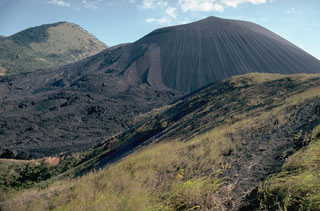Report on Cerro Negro (Nicaragua) — May 1995
Bulletin of the Global Volcanism Network, vol. 20, no. 5 (May 1995)
Managing Editor: Edward Venzke.
Cerro Negro (Nicaragua) Increased seismicity precedes explosive ash eruptions in late May-June
Please cite this report as:
Global Volcanism Program, 1995. Report on Cerro Negro (Nicaragua) (Venzke, E., ed.). Bulletin of the Global Volcanism Network, 20:5. Smithsonian Institution. https://doi.org/10.5479/si.GVP.BGVN199505-344070
Cerro Negro
Nicaragua
12.506°N, 86.702°W; summit elev. 728 m
All times are local (unless otherwise noted)
Seismicity recorded during 24-28 May at the CNGN station (~500 m E of the crater) consisted of tremor lasting from 30 minutes to several hours; dominant frequencies were 1-3 Hz. Additional microseismicity recorded there was not strong enough to be detected by instruments ~15-20 km away. Fumarolic activity through 28 May had changed little since the last phreatomagmatic eruption in April 1992.
In the late afternoon on 28 May, small ash-bearing explosions were observed by N-flank residents. A news report noted that the explosions caused some residents to leave their homes and seek shelter in the nearby city of Malpaisillo. Activity during 28-31 May consisted of ash plumes rising at least 100 m above the crater rim. Explosions during the days occurred once or twice per hour. Tremor was also recorded, including episodes lasting ~30 minutes. INETER reported the increase in activity to Nicaraguan Civil Defense on 25 May, and informed the mass media and population on 29 May.
On 30 May a group of French scientists visited the crater. During this time, seismicity measured at the foot of the cone remained very low. They noted that a new vent had formed in the bottom of the central crater (~120 m deep and ~250 m across). The vent, ~10-15 m in diameter and "some meters deep," was located on the W rim of the pipe that opened in 1992. All of the central crater fumaroles, located along dikes on the floor, were undisturbed, and emitted gases with a temperature of <=350°C. Weak degassing occurred between rhythmic explosive phases lasting 20-30 minutes. Observers on the crater rim during the night of 30 May saw incandescent material thrown 200 m high. Although there was no activity for >20 hours on 31 May, activity had resumed during a 1 June visit.
An early June aviation report noted sporadic columns of ash to 2-km altitude. Activity was continuing through late June; additional details will be provided in the next Bulletin.
Geological Summary. Nicaragua's youngest volcano, Cerro Negro, was created following an eruption that began in April 1850 about 2 km NW of the summit of Las Pilas volcano. It is the largest, southernmost, and most recent of a group of four youthful cinder cones constructed along a NNW-SSE-trending line in the central Marrabios Range. Strombolian-to-subplinian eruptions at intervals of a few years to several decades have constructed a roughly 250-m-high basaltic cone and an associated lava field constrained by topography to extend primarily NE and SW. Cone and crater morphology have varied significantly during its short eruptive history. Although it lies in a relatively unpopulated area, occasional heavy ashfalls have damaged crops and buildings.
Information Contacts: Wilfried Strauch, Instituto Nicaraguense de Estudios Territoriales (INETER), Division of Geophysics, Managua, Nicaragua; Alain Cruesot-Eon, French Embassy, Managua, Nicaragua; United Press International (UPI); International Civil Aviation Organization, Air Navigation Bureau, 1000 Sherbrooke Street West, Suite 400, Montreal, Quebec H3A 2R2, Canada.

